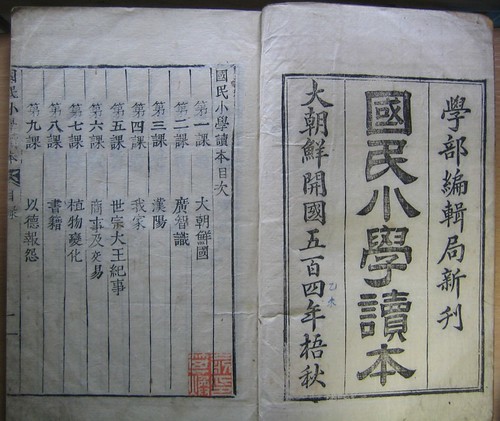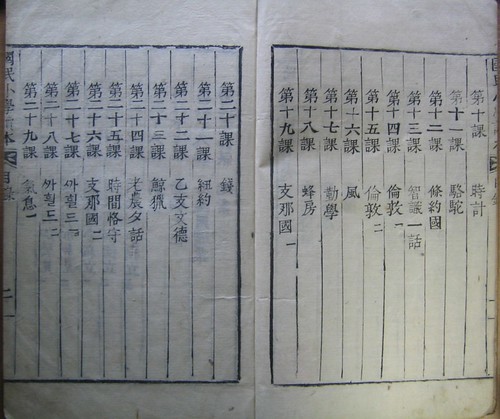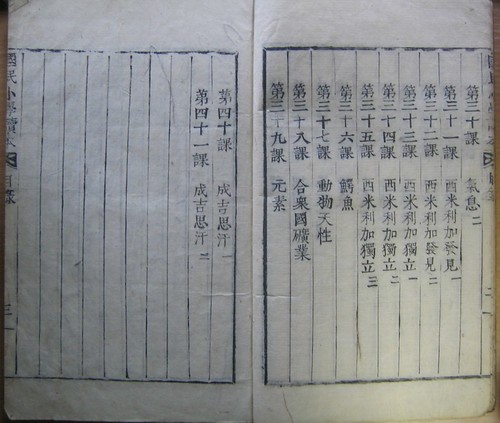
At my own blog I’ve been writing a series of posts about some interesting old Korean books I’ve come across in the library of the School of Oriental and African Studies. This is actually no. 5 in that series, but I thought that it would be worthwhile crossposting it here. A list of the previous entries in the series can be found at the bottom of this post.
The book in question is probably the first modern textbook produced in Korea. Entitled An Elementary Reader for Citizens (國民小學讀本), it was first published by the education ministry of the country that was then known as Tae Chosŏn’guk (‘Great Chosŏn Nation’) in 1895, or year 504 of the dynasty, if you use the short-lived dating system that was current at the time.
A facsimile edition was published in the 80s which still seems to be available at secondhand bookshops. It is certainly a book that I’d like to get around to looking at in greater detail. The first attempt at creating some sort of general, state-led educational material in Korea must have echoes that can be seen and felt even today, 111 years later. It is also fascinating to see what these early educationalists thought was important for the citizens of Chosŏn to know about. And some of the language used, even in the chapter headings, is interesting too, like the use of the word Chinaguk (支那國) for China instead of Chungguk (中國).

The title page and first page of contents.
The book contains 41 lessons/readings in all, covering everything from the American War of Independence to camels. Here are the titles of the first 12 lessons:
Lesson 1: Great Chosŏn (大朝鮮國)
Lesson 2: General Knowledge (廣智識)
Lesson 3: Hanyang [Seoul] (漢陽)
Lesson 4: Our Family (我家)
Lesson 5: The Reign of King Sejong (世宗大王紀事)
Lesson 6: Commerce and Trade (商事及交易)
Lesson 7: The Transformation [evolution?] of Plants (植物變化)
Lesson 8: Books (書籍)
Lesson 9: Getting Revenge through Kindness (以德報怨)
Lesson 10: Clocks (時計)
Lesson 11: The Camel (駱駝)
Lesson 12: The Treaty Powers (條約國)
I think some of my translations probably leave something to be desired, so any suggestions or corrections would be welcome. Or perhaps you might like to translate some of the rest of the lesson titles. Here are the rest of the contents:
Korean books at SOAS, previous entries:
Part one
Part two
Part three
Part four


What a fantastic book! I would love to look at it. This really ought to be completely scanned and put online. Somehow I suspect the copyright has expired! If there are ever any volunteers I would volunteer the space/bandwidth.
It does look interesting. I’m especially curious about the chapter on camels and the two-part story entitled ‘Gerhilde’ (one of the Valkyries I believe, but this could be my misreading of the han’gŭl).
Scanning it sounds like a great idea. It would be nice to have a little 자료/materials section at the Well. There probably already is a scanned version out there, but I expect its access would be limited to the National Library of Korea or somewhere like that. I don’t really know anything about the copyright regulations on this sort of thing, but assuming it is ok I would be happy to help in getting it up online.
I expect you’ll find that there’s a copy of either the original or the facsimile at the Yenching Library.
We should have a 자료 section! I am thinking of re-uploading my old “East Asia Archives and Libraries” wiki to Frog in a Well – used to be hosted at chinajapan.org but taken down after I had to switch providers…
Looks cool! I’m currently writing my thesis on the Imjin Waeran (Bunroku no eki/ Renchen Zhanzheng)as “lieu de mémoire” in modern East Asia and it would be interesting to know if Hideyoshi’s invasion is mentioned somewhere in the text?
Hinrich: to be honest, not having read the book I couldn’t really say if there’s anything in there about the Imjin Waeran. Although having looked over the chapter titles I can’t see anything that obviously relates to Japan or that particular part of Korean history.
Actually, I’ve just realised that readings 14 and 15 are about London, using the Chinese characters 倫敦 ‘yundon’, which I haven’t seen before. As a Londoner I’m now quite keen to see what an 1895 Korean book has to say about the place. Also, the final two readings (40 and 41) are on Chinggis Khan (成吉思汗).
Hi all, nice to meet you. My name is Ellie and I am a student here at Harvard. Konrad was kind enough to invite me to the website a while back, but I have not had a chance to post before.
Hinrich: My dissertation is actually on the historical figure of Yi Sunsin as a nationalist trope (like John Dower’s “bridge of meaning”) in every decade of modern Korean history, so I think we have some common research interests! From the comments above I am assuming you are looking at the event not only in Korean nationalist memory but also the Japanese and Chinese. Interesting. I would be interested in your framework thus far. I have a dissertation proposal now of about 100 pages covering Sin Ch’aeho’s treatment of Yi Sunsin and Yi Kwangsu’s later fiction. This year I will be looking at more representations from later decades, Park Chunghee’s appropriation, etc. In addition to historical texts, I also look at the event in modern Japanese literature too. For instance, this past year, I translated Akutagawa’s short story about General Kim during the Imjin Wars with Prof. Rubin here. There is also Tanizaki’s loose treatment in his Seven Short Stories?
Anyway, sorry to go on. I am a bit excited to find someone else with similar research interests!
Hinrich, wonderful that you are working on Imjin Waeran…I wish there was more in English on it…
Just out of curiosity, are the titles of Ch. 27 and 28 in Chinese and Korean? Wae Field? Or just in Korean? Something like Sga field?
Chapters 27 and 28 look to me to be titled only in han’gŭl. I’m no expert on old han’gŭl orthography but I read the first syllable as kka/까, since I believe that the tensed sounds used to be written with a siŏt at the beginning.
Thanks to your question I’m rethinking my earlier guess that these chapters concerned Gerhilde. It seems more likely that they may be about US president James A. Garfield who was assassinated in 1881. Only a proper look at the book will resolve this, but since it is now in the special collections section of the library, that will have to wait until I have time.
Thanks, Owen. I myself cannot have an access to this text either.
But I may agree with your guess about Garfield, considering the year of its publication.
Dear Ellie,
I’d love to get in touch with you! It’s wonderful to find someone with similar academic interests. Can you get my mail from Konrad?
Your focus is on literature? Ah, I’m more into museums, television dramas and history textbooks as examples of how East Asians produced iconic images around the Imjin War after 1945.
BTW: There is an English article on the metamorphoses of „Admiral Yi“, the „Korean Nelson, though: Roh, Young-koo: Yi Sun-shin, an Admiral Who Becam a Myth. In: The Review of Korean Studies Vol.7 (2004). p. 15-36.
It is quite tricky to get in touch with Chinese experts on the Imjin War these days as – among other things – everything concerned with the history of NE-Asia has turned into a very sensitive topic in the People’s Republic thanks to the latest Korean claims on the Jiandao/Gando-region.
I wish you – and of course all participants in this online-project – a splendid and successful 2006!
The “Elementary Reader for Citizens” raises questions. Was it meant as a textbook for adult or juvenile learning? My limited reading credits the Japanese with establishing the first true Public school system in Korea. This book, if for juveniles, suggests that the Yi dynasty had established, or was in the process of establishing, a public school educational system beyond that of the Confucian schools for the sons of Yangbang. The content likewise suggests that western missionaries were involved in the selection of some of the materials included.
The first „modern“ school in Korea seems to have been the Wonsan Haksa (1883). Koreans were obviously quite interested in establishing a national system of education even before 1905. You might want to have a look at Lee, Yoonmi: Modern Education, Textbooks and the Image of the Nation. Politics of Modernization and Nationalism in Korean Education, 1880-1910. New York: Garland Publishing, Inc. 2000.
Hinrich, thank you for the cite. I’ll check it out.
My opinion is that “Elementary School Reading Text” is a better translation of the book.
I have noticed that there is virtually no or very very limited information on Japan’s kidnapping of Korean potters during the Imjin Wars and what legal actions have been taken or any legal resolutions, if any. Can anyone give me guidance to locate information on this topic?